By Chris Ayliffe, Arctic Meta
Frequently, when travellers visit our shores they’re usually asking 2 questions: what are the best places to see in Iceland? And, where is the best location to see the Northern Lights?
Believe me, we get it – a trip to Iceland isn’t complete without seeing some truly awesome natural attractions, and also a lucky glimpse of nature’s greatest show, the Northern Lights.
After all, for most people a trip to Iceland is a once in a lifetime experience, and one which you don’t want to waste a minute missing out on some of the most incredible things to see and do in Iceland.
It’s also often the same case with the locals; particularly those who have suddenly reconnected with the island after the recent COVID restrictions have impacted the ability for international travel. This period has enabled a great many people to take a breath and realise how truly special the environment and the nature is around them – I have never witnessed so many locals excited to see and photograph an upcoming Northern Lights show until now.
In this guide, I’ll highlight some of the most incredible places to see the Northern Lights in Iceland, as well as highlight the places and times of year that will give you the best statistical chance of seeing the dancing colours on the canvas of an Icelandic night sky, as well as the conditions you’ll need to keep on top of.
The Best Locations to See the Northern Lights in Iceland
This list took me a good deal of time to mull over, and I’m sure there are plenty of Aurora enthusiasts who would disagree with some of the top spots I’m putting on my list, but I’m basing these on my own experience of capturing the best Northern Lights displays in Iceland.
1. Grotta Lighthouse
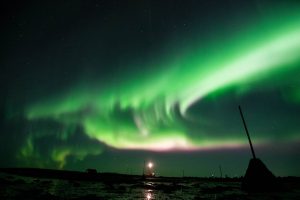
Source: FrozenBritAbroad
This is the perfect location for if you’re only planning on staying in or around Reykjavik during your time in Iceland.
It’s the ultimate combination of being located very close to the city and a perfect dark spot to avoid the glare of the nearby urban lights.
Perhaps I’m biased due to this location’s personal convenience to me, but it’s by far been the most reliable spot I’ve visited for catching some truly awesome Northern Lights displays near Reykjavik.
As it’s located on the edge of the Seltjarnarnes peninsula, the photographers amongst you can easily get a cool shot of the Aurora with the incredibly picturesque lighthouse in your frame. Or you can equally set up your camera on a tripod to face north while you rest your feet in an Icelandic hot spring known as Kvika – a great Reykjavik hidden gem!
There’s something beautiful about remaining in the moment whilst watching the sky ignite and dance over the adjacent snowy Mount Esja across the bay.
2. Thingvellir National Park
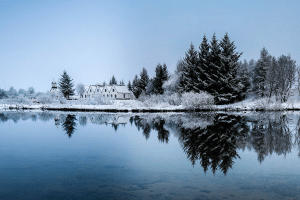
Source: Wikimedia. CC. Jon Gretarsson.
Thingvellir (or ‘Þingvellir’ in Icelandic) is the perfect spot if you’re an avid photographer, are staying in the Golden Circle or near Reykjavik and don’t want to travel too far to capture a great Aurora Borealis show.
The reason for this is the sheer number of fantastic foregrounds you can choose from depending on the Northern Lights position in the sky on a given evening and your own personal preference.
For instance, if you’re looking for a wide landscape shot, from car park 5 there is a short walk by the lake facing Thingvellir church across the water. From here your shot can capture a beautiful foreground of the lake, the church and the mountains in the distance.
Alternatively, if you’d much rather go in search of the incredibly picturesque natural Northern Lights reflection in the water, then setting up your tripod near Silfra is a must.
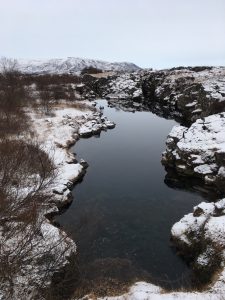
Source: FrozenBritAbroad
As a rift between both the Eurasian and North American tectonic plates, this perfectly still and silvery water can capture the most perfect reflections you’ll ever witness of the Northern Lights. Plus, you’ll know that your photo was taken directly between 2 of the world’s largest tectonic plates – a pretty epic story to tell in my eyes!
Finally, you could instead opt for watching the Aurora by the incredibly picturesque waterfall of Öxarárfoss. At just a short walk from the car park, this is usually the most secluded spot at Þingvellir National Park for Northern Lights enthusiasts.
Whichever location you choose, you’ll be in for a treat if you get lucky with the required Northern Lights viewing conditions.
3. Kirkjufell

Source: Wikimedia. CC. Vaidyanathan.
For those of you planning on booking one of the fantastic Iceland self-drive tours around the island, you’ll almost certainly spend some time on the immaculate Snaefellsnes peninsula at some point on your travels.
Known as ‘Iceland in miniature’, this peninsula is rich for its myriad of natural attractions and landscapes. It includes luscious waterfalls, distinctive mountain ranges, quaint fishing towns, lava fields, deep craters and even the huge glacier of Snæfellsjökull.
However, as the most photographed mountain in Iceland, Kirkjufell is situated just outside of the small town of Grundarfjörður. Though the name directly translates to ‘church mountain’, it’s actually now more commonly known to travellers as ‘the mountain shaped like an arrowhead’ thanks to its feature in the hit HBO series, Game of Thrones.
When it comes to seeing the Northern Lights, nothing is more rewarding than seeing the powerful curtains of light dance around one of the most spectacular mountains in Iceland.
If you’re a keen photographer, you will have 2 main options to composition your photo. Firstly, you can choose to park opposite the mountain in the main car park, and walk around 100m behind the adjacent waterfall, Kirkjufellsfoss.
From here you can face north and frame the perfect shot of the Northern Lights, Kirkjufell and Kirkjufellsfoss (see the above image).
Alternatively, for those of you who’d much prefer a humble Northern Lights reflection in your frame, then I suggest driving back around 400m towards Grundarfjörður, parking in a layby on the opposite side of the road and carefully walking towards the waters edge.
Make sure you bring a torch with you, as the last thing you want is to accidentally stumble into a lake! Particularly, in winter!
4. Myvatn
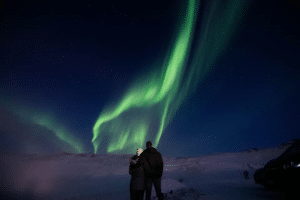
Source: FrozenBritAbroad
People from North Iceland will regularly claim that they get the best Northern Lights in Iceland.
At around 1.4 degrees further north than the capital region, part of their claim is justified. However, when it comes to seeing the Northern Lights in Iceland, if it’s visible in one part of the country, then everywhere else will also be able to see it, pending cloud cover.
However, that being said, perhaps one of the most surreal experiences I’ve had of the Northern Lights was in North Iceland. I was spending some time in the region of Mývatn with an early winter evening of bathing in the Mývatn nature baths under a beautiful sunrise that perfectly glistened on the snowy surroundings, to then walk out to my car under one of the most intense Northern Lights displays I’ve seen to date.
The region itself was formed 2300 years ago by a huge lava fissure eruption. It resulted after a series of volcanic craters erupted across a range of 12km. Afterwards a river was blocked by the quick development of a huge lava field leading to the creation of the selection of lakes you can visit today.
Nowadays, it’s home to Iceland’s 5th largest lake as well as a myriad of other fantastic spots to check out. These include the ancient lava fortress of Dimmuborgir, Grjótagjá cave (another site shown in Game of Thrones), and the geothermal hotspot of Hverir.
For those of you planning on spending some time in the region, I would highly recommend Mývatn as one of the best places in Iceland to see the Northern Lights.
With the perfect cocktail of perfect darkness, a series of scenic natural landmarks, and being that extra bit further North, the Aurora displays from Mývatn can be particularly stunning to behold.
5. Jökulsárlón Glacier Lagoon
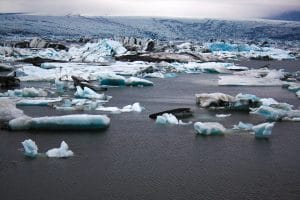
Source: Wikimedia. CC. Hedwig Storch.
Iceland’s South Coast is one of the most popular travellers routes in the whole country, second only to the Golden Circle, and for good reason. There are an incredible abundance of magnificent waterfalls, black sand beaches, glaciers, volcanoes, sea stacks, Puffin hot spots, and of course the famous Jökulsárlón glacier lagoon.
It’s one of the most rewarding journeys you’ll take across Iceland. The landscape changes every hour, and there are magnificent natural attractions around every corner and bend in the road.
However, Jökulsárlón glacier lagoon stands alone as the South Coast’s best attraction, and is nowadays known as Iceland’s ‘jewel in the crown’.
In actual fact, it’s a glacial lake that’s formed at the base of Breiðamerkurjökull glacier, an outlet of Europe’s largest glacier, Vatnajökull.
Not only is this lagoon the deepest lake in Iceland, but it’s also full of a series of breathtaking gargantuan icebergs which have broken off the glacier wall which then float their way out to sea.
On the opposite side of the road, there’s Iceland’s famous Diamond Beach, filled with a series of washed up icebergs from the lagoon thanks to the somewhat bizarre sea currents at play.
It goes without saying that this is one of the most unique natural spots to visit in Iceland. And, if you’re wanting to see the Northern Lights, this setting is perfect for some incredible photos and some truly amazing cosmic shows.
This is particularly true when auroral activity is high – the waters and icebergs deep into the lagoon can light up under the powerful brightening skies above.
If you’re planning to travel along this region of the country or simply joining a fantastic Iceland South Coast tour, you’ll want to ensure an evening at Jökulsárlón glacier lagoon is high up on your list of activities.
6. Panorama Glass Lodge
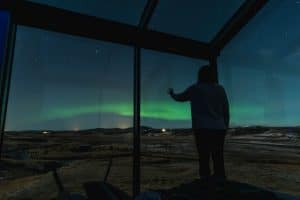
Source: FrozenBritAbroad
I know, I know, of course I’m going to recommend the Panorama Glass Lodge as one of the best locations in Iceland to see the Northern Lights.
However, this is for good reason; the Panorama Glass lodge is the only place in Iceland which successfully combines luxury with Northern Lights viewing.
I would classify this as by far the most romantic option available in Iceland.
After all, you could spend a series of nights hunting the Northern Lights down, standing in the cold for hours on end in the hope of a glimpse of the ethereal beauty. Or, you could watch from inside a warm and luxurious Icelandic lodge which is the perfect size for a couple, and even has a private hot tub you can relax and watch from.
The location is also outstanding for Northern Lights enthusiasts – it’s situated within a perfect dark spot well away from any urban artificial lights, and the views include the active volcano, Hekla.
This means you will have the perfect location to see the Northern Lights and the Milkyway cosmic band, as well as the ability to frame some amazing photos of the skies, the lodge and Hekla in the distance.
If you’re looking for the perfect holiday unwind combining romance with the Northern Lights, then the Panorama Glass Lodge has to be on your list of places to stay and experience.
What is the Best Season for Seeing the Northern Lights in Iceland?
If there’s one thing you take away from this article it’s this – you can only see the Northern Lights in winter, winter, winter, winter, winter, winter! And, by winter I mean from September to April.
I hope that’s super clear! You’ll want to consider booking an Iceland winter holiday package, and definitely not a summer one!
In Iceland, there really are only 2 seasons: winter and summer. If you ask an Icelander about either autumn or spring, they will most likely give you the same response – “we have about 2 days of both!”
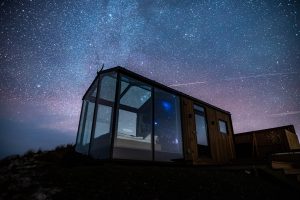
It’s true, the climate seems to change in the blink of an eye from endless sun to endless night. For Northern Lights hunters, it’s the endless night you should be chasing.
To be factual, it’s never 100% dark or light, but at the peak of winter during December Iceland only experiences around 4 hours of actual daylight each day (11:22am – 3:29pm). As much as this can make for some much earlier yawns from both locals and travellers alike, it gives plenty of opportunity to see the Northern Lights.
For example, you cannot see the Northern Lights without darkness. Although the ethereal greens, pinks, blues, reds, whites and purples are always present, it’s the darkness that allows us to actually see them.
During Iceland’s summers, though we’re unable to watch the Northern Lights for over 3 months, we are blessed with the extremely long hours of daylight under the midnight sun.
Essentially we go from the sleepy cold part of the year to the bright insomnia months of the year!
What is the Best Month for Seeing the Northern Lights?
Though you can see the Northern Lights from the end of August until early April, there are specific months which will give you the advantage.
Purely from a practical perspective, the biggest enemy for Aurora hunters are the clouds.
This is because the Northern Lights actually occur at altitudes 80 – 640km above sea level, and clouds rarely exceed 18km up.
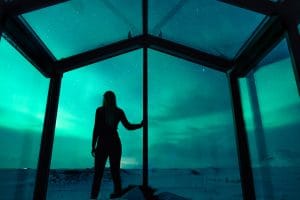
Sadly, cloud cover is one of the most infuriating elements to deal with when you want to get a good show of the Northern Lights.
However, rest assured the best Iceland Northern Lights tours and most experienced experts will always remain vigilant to the latest meteorological data before your trip. This will help the guides know where the best places to take you each night for the best chances of witnessing a Northern Lights show.
During winter, statistically the worst cloud cover occurs between December to February. Contrastingly, from my experience, September, October and March provide the most number of nights without heavy cloud cover.
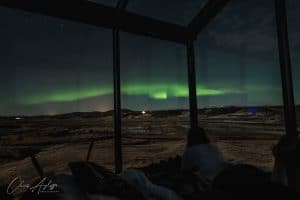
Source: FrozenBritAbroad
In Iceland, December is usually the worst month of the year for storms. This often brings strong winds and of course clouds. However, the autumnal months and early spring are a little more temperate and frequently have a lot less volatile weather conditions.
Next, the Aurora is also scientifically considered to be more active and powerful around both the Autumn and Spring equinoxes.
This means that it’s believed that the best time of year for getting the most explosive Northern Lights activity is around both the 3rd week of September and March, respectively.
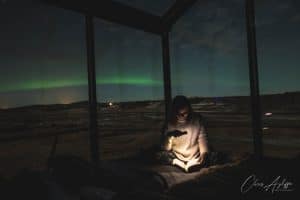
Source: FrozenBritAbroad
One of the theories behind this belief is the “Russell-McPherron effect”. In simplicity, this leading hypothesis indicates that due to the Earth’s seasonal position and the positive statistical evidence for a greater volume of geomagnetic storms emitted from the Sun, that at these times of year travellers have the best chance of catching the Northern Lights.
The Russell-McPherron effect is also backed up by another theory known as the “equinoctial effect”. This explains that during both the Autumn and Spring equinoxes, the Earth’s 2 magnetised poles sit at a perfect right angle to the Sun’s solar wind flow twice a day. This positioning drives the strongest solar wind directly towards the Earth’s magnetic poles which is the main driver for Northern Lights activity.
It’s a lot to take in, but in simplicity, around the 3rd weeks in September and March are the best months and dates to see the Northern Lights in Iceland.
What Are the Best Conditions to See the Northern Lights?
When it comes to hunting the Northern Lights, you need 2 natural ingredients to be on your side, as well 1 extra element to give you the best possible chance.
1. Cloud Cover
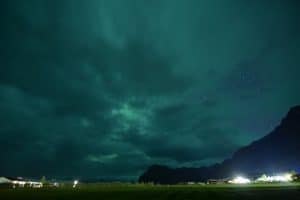
Source: FrozenBritAbroad
As mentioned earlier, when it comes to getting a glimpse of the Northern Lights, there is nothing more infuriating than cloud cover.
To be clear, if there are loads of clouds above you, you’re not going to see the Northern Lights at that moment.
The trick to avoiding this is to keep up to date with the latest cloud cover forecasts. Fortunately, Vedur is an Icelandic website which tracks and predicts all meteorological activity for 2.5 days into the future.
You want to keep an eye on this map when you plan a location to go hunting for the Aurora. My advice is to check every few hours, and look for the white areas on the map – if it’s ‘white’ it’s predicted to be clear.
Sadly, avoiding the clouds and spotting the gaps are part of the game when it comes to chasing the lights. However, you may just get completely lucky and have some wonderfully clear skies even when staying in Reykjavik – you then need to check out the best locations to see the Northern Lights from Reykjavik.
2. Auroral Activity
The second natural element to keep monitoring is the auroral activity.
Now, this element can send you down a rabbit hole of pages and pages of articles, statistical information and a series of bad apps to download.
My advice is to keep it simple, and simply check the Space Weather Live website. This will give you as much or as little depth of information as you can handle. They provide an Aurora Forecast for 30 days as well as up to the minute stats so you can check if the auroral activity from the sun might be picking up or not.
It’s also worth understanding that auroral activity is measured on a scale known as the Kp-index. Without an overly technical explanation, it works out an average level of geomagnetic activity over a 24-hour period – the higher the number, the stronger the Aurora.
The scale goes from 0-9, and in my experience anything above Kp 2 with a clear sky in Iceland will give you the chance of seeing the Northern Lights. Fortunately for travellers, the Kp-index is very rarely below 2.
With that being said, keep in mind that this scale is based on a 24-hour average. Local conditions are more often than not a volatile series of peaks and troughs. This means that even if it’s considered Kp-4 conditions, there may be lulls in activity where you will see nothing, and highs where you might get the most intense Northern Lights of your life!
Believe me, I’ve experienced the highs and lows of both, but it’s such good fun!
EXTRA: Luck
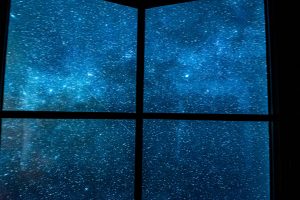
I know it’s a massive cliche, but when it comes to the Northern Lights the crucial extra element you need with every hunt is nothing more than luck.
There have been so many occasions where the conditions have been favourable and I’ve pitched up by an iconic spot in Iceland with my camera at the ready, to wait, and wait, and wait…and wait.
Over my time photographing the Northern Lights in Iceland, I’ve realised how vital patience and a bit of fortune can be.
For instance, on many occasions I’ve seen cars and tour buses heading straight back for Reykjavik in the belief that the main event is over, only for the most incredible rhythmic dances and colours to appear right over my head – I’ve been left enjoying the best Northern Lights shows of the night completely alone because most people give up hope too quickly.
Keep your patience, take test shots facing north if you have a camera, and remember that though good things take time, great things happen all at once.
Conclusion
I hope this guide has provided you with some helpful advice and tips on the best locations in Iceland to see the Northern Lights, as well as when to come and what conditions you need to keep an eye on.
In all of my experience of hunting down the perfect Aurora Borealis locations, or framing the best shots, seeing the Northern Lights really comes down to a combination of patience and luck.
Just remember, that when you’re venturing out on those cold winter nights in the midst of Iceland’s rugged natural terrains and deep snow drifts, keep the faith, look north and don’t give up!


